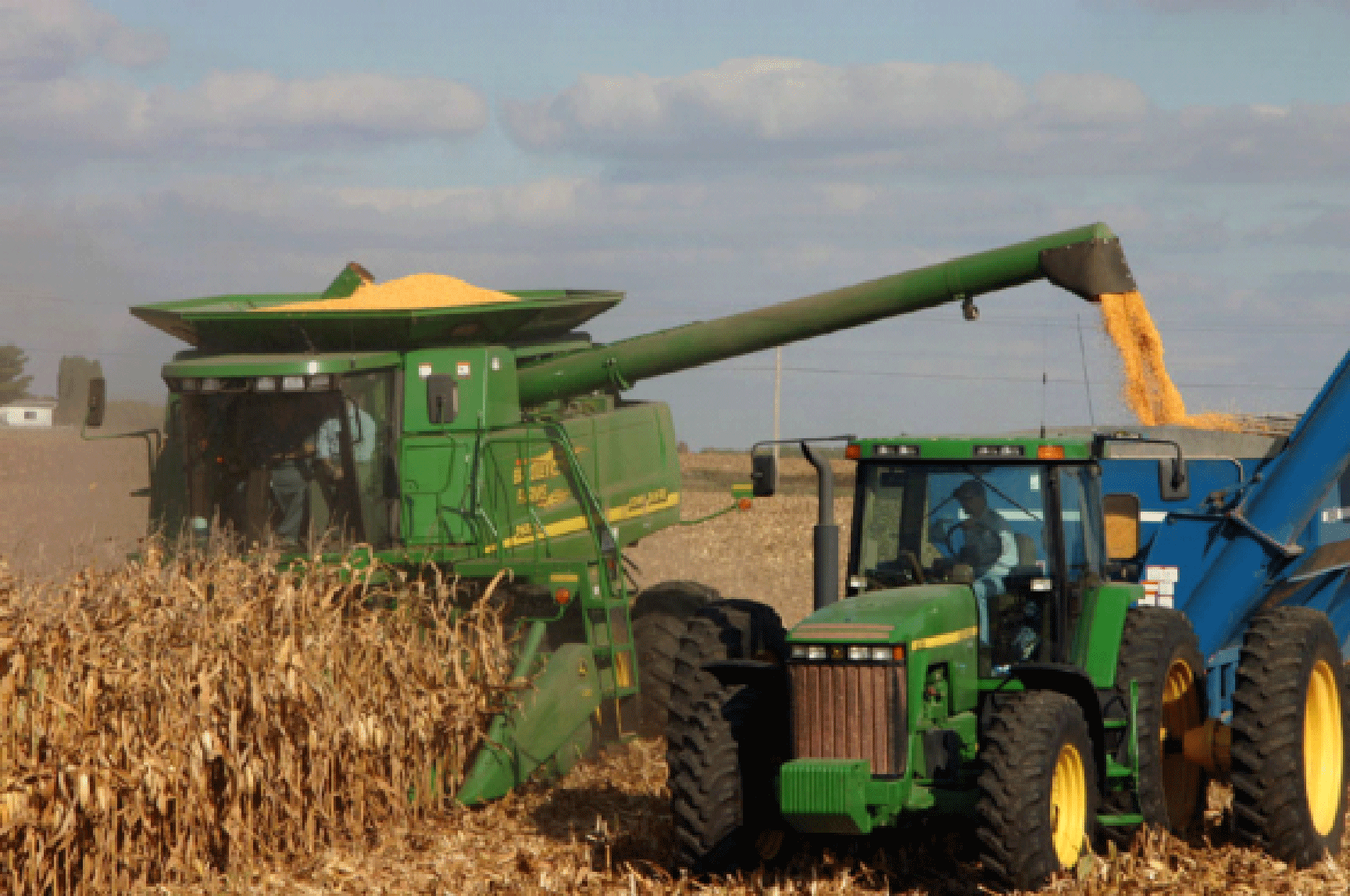 Photo courtesy of Wisconsin Farm Bureau Federation
Photo courtesy of Wisconsin Farm Bureau Federation- General Safety and Health Issues
- Corn Harvest
- Grain Bin Safety
- Grain Auger Safety
- Summary
- References
The purpose of this bulletin is to address safety issues inherent to corn production before and during a corn production season. We have divided safety issues into General Health and Safety, Corn Harvest, Corn Grain Bin, and Augers. Safety tips are presented that should be reviewed by anyone involved with corn production on the farm.
General Safety and Health Issues
Proper Clothing
It is extremely important to use proper clothing when working with any type of farm equipment. This is the first step to working with equipment safely. Follow these guidelines:
- Wear close-fitting clothing to reduce the chance of catching or getting grabbed by moving machinery.
- Wear long pants that are the correct length. Pants too long are also easily caught on moving machinery.
- Put loose hair inside a cap. Loose hair can be grabbed by moving pieces. A cap also helps shield from sun radiation.
- Do not wear jewelry. Necklaces and rings are easily caught by machinery.
- Wear hard shoes or boots with slip resistant treads; steel-toed boots are recommended.
Effective Communication
Tractors, combines, augers, fans– all these are loud and change the way we communicate instructions around equipment. If two or more people are needed to position, adjust or service a machine, make sure everyone knows what is being done and how to communicate with others. Learn the following hand signals and use them to reduce the risk of misunderstood instructions or instructions not heard.
Hand Signals for Use in Agriculture (ASAE Standards)
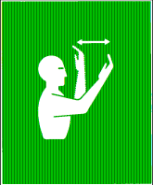 Come to me
Come to me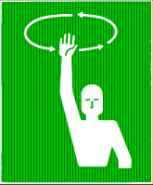 This far to go
This far to go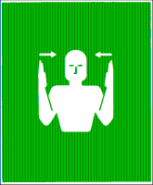 Move toward/follow me
Move toward/follow me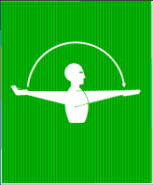 Move-out / Take-off
Move-out / Take-off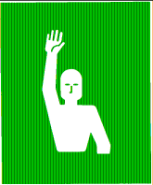 Stop
Stop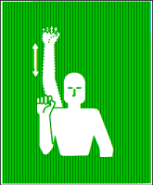 Speed it up
Speed it up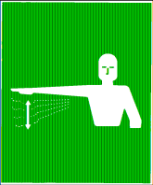 Slow it down
Slow it down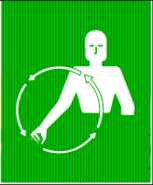 Start the engine
Start the engine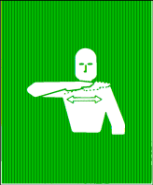 Stop the Engine
Stop the Engine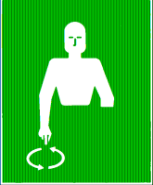 Lower equipment
Lower equipment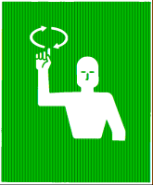 Raise equipment
Raise equipment
Child Safety
The Marshfield Clinic National Farm Medicine Center has developed North American guidelines for Children’s Agricultural Tasks. These guidelines refer to the latest research to help farmers and their families assess the appropriate agricultural tasks for children based on age and risk-taking personality. These guidelines can be accessed at www.nagcat.org. Please refer to these guidelines to assess your child’s ability to safely perform agricultural tasks.
Dust and Mold
Spoiled grain releases dust and mold spores into the air during handling. Exposure to fungus from moldy grain can cause allergic reactions characterized by chills, high fever, swelling, vomiting, dizziness and shortness of breath. The lungs can fill with fluid and collapse. Dust from grain can affect you in a variety of ways. While some may not be bothered, others can suffer from serious respiratory problems, digestion and stomach problems and/or skin rashes.
- To help reduce and prevent allergic reactions, you and other workers should wear proper protective gear and/or avoid dusty areas. An approved dust mask that fits tightly around the mouth and nose area effectively protects you from fungus present in moldy grain.
- Ventilate the work area while you clean out a grain bin or work with dusty grain.
- Upon entry, wear a respirator suitable for protection from dust, unless a known chemical is present, then wear the proper respirator for that situation.
Nuisance dust is light enough to be carried by air currents and small enough to be inhaled and deposited in your lungs. A common danger in the air, this dust can accumulate and turn parts of the lung into non-functioning, hardened tissue. Inhaled dust also encourages the growth of organisms that causes of tuberculosis and bronchitis. If you choose not to wear proper protection, there is a good chance you will have an allergic reaction and have breathing problems the rest of your life.
Fumigants
Another potential health hazard exists during and after fumigation of a grain bin. Fumigants are toxic when inhaled, swallowed, or absorbed through the skin. If you follow safety procedures, you can eliminate the potential for poisoning.
- Ventilate fumigated bins for several hours or longer if recommended by the pesticide manufacturer or the EPA before reentering.
- Observe and follow all label recommendations.
- Select and fit the proper gas mask and canister and use them correctly.
- Use only those gas masks and canisters that have been tested and approved by the National Institute for Occupational Safety and Health (NIOSH) or the U.S. Bureau of Mines.
- Post warning signs alerting people to the dangers of fumigation.
- Always run the ventilation fan before entering the bin to ensure that the environment is not immediately dangerous to your life and health.
Most producers find that it is often safer, cheaper and more effective to have their stored grain fumigated by a licensed, professional fumigator.
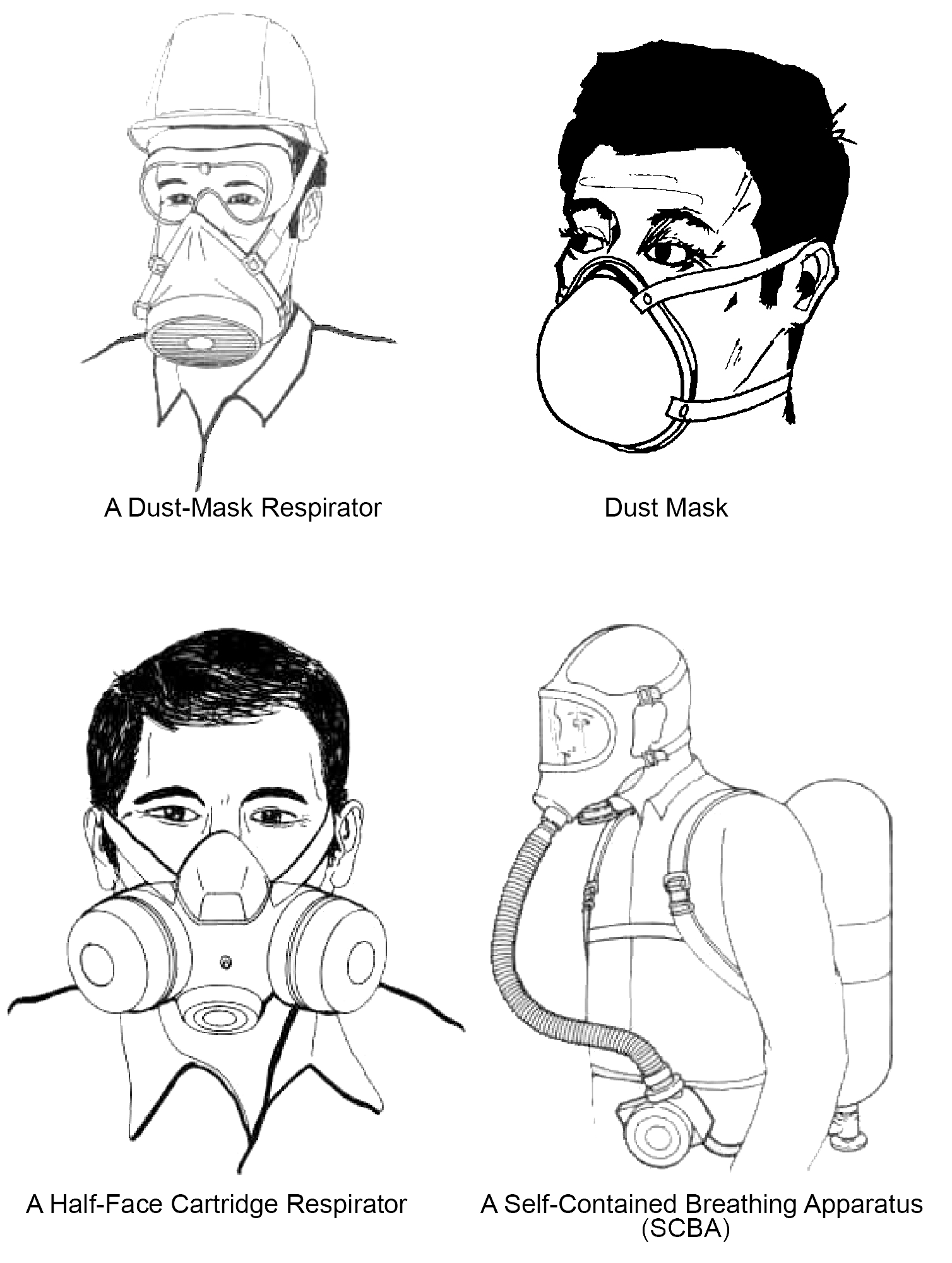
Carbon Dioxide
Wet grain ferments when it is stored. Fermentation produces carbon dioxide (CO2), a colorless, odorless gas. Carbon dioxide is heavier than air and pushes it out of the bin resulting in an oxygen-deficient atmosphere. If you enter a grain bin where carbon dioxide is present, it gets into your bloodstream and slows down your breathing, causing drowsiness, headaches, and even death by suffocation.
- If you suspect the presence of carbon dioxide in the grain bin, don’t go inside. To reduce the hazard, open manholes and all side door openings and force air through the bin.
- If you attempt a rescue in an oxygen-deficient atmosphere, you must have a self-contained breathing apparatus (SCBA).
- Your local emergency rescue team is trained and has the equipment to help in this type of an emergency. Call them immediately.
Fire and Explosion Hazards
A build up of grain dust can be ignited by a heat source such as fire, sparks, or hot bearings. When contained dust is mixed with air, an explosion can occur.
To reduce the possibility of a fire or explosion:
- Never weld or grind in a bin containing grain.
- “NO SMOKING” signs should be posted in key locations and strictly enforced.
- Perform routine maintenance to reduce risk of ignition due to machinery failure.
Corn Harvest
Real-World Incident (NIOSH FACE Report 06MN009)
A 27-yr old farmer drove a tractor pulling a corn picker and wagon to a cornfield near his farm place. While he operated the tractor and corn picker, he apparently noticed a problem with the corn picker and stopped the tractor’s forward movement to investigate. After he stopped the tractor, he dismounted from it. The tractor engine was left running and the power-take-off was not disengaged. He walked to the area between the back of the operating corn picker and the wagon. For unknown reasons he reached into the area near the husking rollers and apparently the sleeve of his coat became caught between two of the rollers. He may have reacted by placing his other hand and arm in the area of the husking rollers, so his other arm also became caught in the rollers. The rollers continued to pull his arms into the machine and resulted in his neck and chest being pulled tightly against the frame of the corn picker.
A neighbor noticed the tractor and corn picker in the field. He could hear the tractor running but, after it remained in the same spot longer than what he considered a normal stop, he walked to the field to investigate. He found the victim caught in the corn picker. He used his cell phone to place a call to emergency personnel. Rescue personnel arrived at the scene shortly after being notified. They pronounced the victim dead at the scene prior to freeing him from the picker.
Preparing for Operation
Good safety habits are important for anyone who operates a combine, corn picker or other grain harvesting machine. Failure to observe safety practices can be fatal. These machines have many moving parts that need regular adjusting and maintenance. Begin preparing machinery for harvest in the off-season, at least several weeks before using it. It takes time to get these machines into efficient, safe operating condition.
- Confirm that all driveline components are in good condition and properly shielded.
- The work area surrounding the area should have secure footing, and must be free of all debris and tools that could lead to incidental tripping and/or falling.
- Ideally, the work area should be marked off. It is the operator’s duty to ensure that children and bystanders are kept well clear. If anyone not involved in the operation enters the hazard area, equipment should be shut down immediately.
Driving Combines
- You and other combine operators must be comfortable and able to reach the controls easily to operate the equipment safely. Discomfort is not only distracting, it also contributes to fatigue.
- Adjust the seat to your height and reach. Most modern combines have an adjustable steering column for different arm lengths or the standing position.
- Because of the large size of modern combines, extra room is needed for turning, passing through gates and general maneuvering. Know the physical dimensions of your machine.
- If you employ new operators, make sure they are trained on proper operation of the combine. Novice operators must develop a sense of how quickly the back of the self-propelled combine swings around when turning. This is especially important when operating near obstructions or traveling on public roads. The combine could swing into the path of another vehicle or obstacle if the operator does not allow for this hazard.
- Two brake pedals control the individual drive wheels. When used separately, these pedals help with turns. Used together, they stop the combine in a straight line. Uneven brake application will cause the combine to swerve, especially at high speeds.
Combine/Picker Field Safety
- Before operating a combine, remove as many obstacles as possible from the field. Mark any remaining obstacles with a tall pole or stake so they can be seen clearly in the mature crop, especially if they are difficult to see from the operator’s seat.
- Stay a good distance away from ditch banks that could shear under a combine’s weight. Maintain a grass buffer strip at the edge of all ditches at least as wide as the combine’s wheel track.
- Keep everyone else away from the controls while you are working unless they are needed to help. Block headers so they cannot fall while being worked on. Check for overheated bearings and overloaded or slipping belts. They are possible fire hazards.
- Keep the steps and walking surfaces of the combine free of grease and dirt.
- Use handrails to mount and dismount safely. Frost-covered sheet metal is very slippery.
- Avoid using the operator’s platform for storage because the room is needed for the operator. Stored items may be in the way and cause a slip or fall.
- Uniform feeding of a crop in good condition provides a smooth flow through the combine and results in fewer breakdowns. To achieve uniform feeding, use good tillage and planting practices and cut the crop evenly.
- Make sure the header is the right size for the crop and combine.
- Operate the header and combine at the proper speed.
- Never attempt to clear clogged snapping rolls while the power is engaged. Farmers have lost fingers, hands, arms and legs trying to pull a stalk free from an operating picker. You cannot let go of the stalk in time if it clears itself.
- Shut down the machine before attempting to clear a plugged cylinder on a picker/sheller. Husking rolls can catch gloves, fingers or hands.
- Always disengage power before doing any cleaning or adjusting around the header.
- Lubricate and maintain harvesting equipment on a regular basis.
- Refer to the owner’s manuals when maintenance or repairs are necessary.
- Never service equipment while it is running unless the service manual indicates that operating the machinery is necessary to perform the maintenance or repairs.
- Proper field preparation is essential to safety. “Clean” fields before harvesting by removing stones, low branches and other debris that may damage equipment or injure workers.
- Be alert to changing soil conditions; heavy rains may cause gullies or “wash outs”.
- Ditch embankments may give way under the weight of equipment.
- Check tires for proper inflation and soundness.
- If you are driving a machine, communicate with other workers, especially when attaching implements.
- When equipment must be adjusted or serviced in the field, shut down and use lockout procedures to assure yourself that no one else can start the equipment.
- Allow sufficient time for moving parts to stop before servicing.
- Keep hands out of pinch points. Numerous farmers have lost their hands while trying to free jammed chains, belts, etc., when harvesting grain.
- Tractors and combines accept various implements. Be aware that these implements will cause the tractor or combine to handle or operate differently.
- Check for secure connections before operating an implement; use locking hitchpins and safetychains
- During harvesting, stay out of trucks and wagons when grain is being loaded or unloaded. Suffocation can occur when a person is trapped in flowing grain.
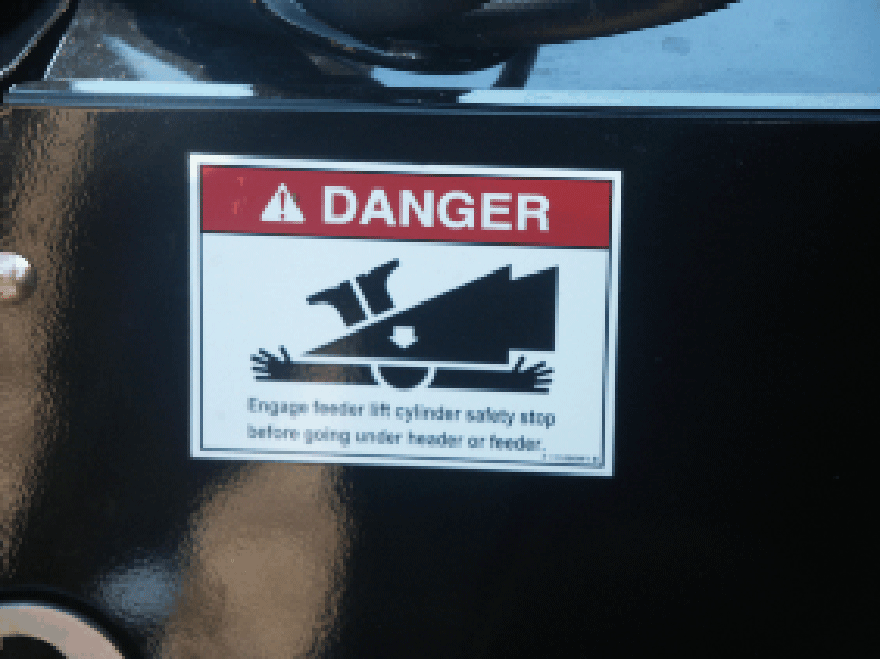 Do not rely on hydraulics when working under header. Use safety stops to secure hydraulic cylinders.
Do not rely on hydraulics when working under header. Use safety stops to secure hydraulic cylinders.Clogged Combines
To clear a clogged combine, first try reversing the header. If this does not work, stop the combine as quickly as possible. Shut off the engine and pocket the key before attempting to clear the machine. The main drive shaft or cylinder should be turned with tools designed for that purpose. Hands should be clear of the combine’s mechanism while the drives are turning. Once the plug has been cleared, remove all tools and replace shields before starting the combine. If the grain gets clogged during unloading, stop the auger before trying to free the grain. Use a small shovel or stick to break the bridging. Never use your hands or feet to remove trash or to push the last bit of grain in the unloading auger. Stop the auger and use a broom.
Highway Transportation
Most agricultural equipment has only one seat for the operator; extra riders are at risk and should not be allowed to ride on any agricultural tractor. Use appropriate safety equipment provided, such as seat belts or harnesses and handrails or footrests.
When operating equipment on the public roads, make sure to properly mark equipment with a slow moving vehicle (SMV) emblem that is securely attached, visible from behind, and has not faded.
Other Combine Precautions
When leaving a harvesting machine, even for a short time, make sure the header is sitting on the ground or floor, supported by solid blocks, or in the up position with the safety stops in place. Shut off the engine, set the parking brake and leave the transmission in gear to prevent the combine from moving. Remove the ignition key. Specialists agree that farm equipment operators should “just say no” to extra riders. Most farm machinery is designed for specialized types of work. It is not meant to carry passengers unless equipped with a special seat.
Grain Cart
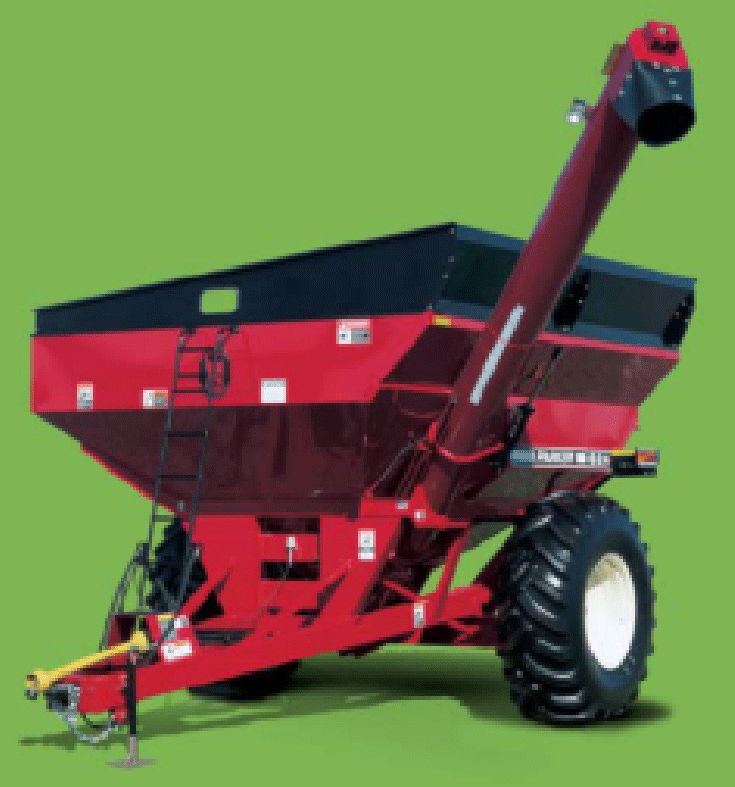 Do not rely on hydraulics when working under header. Use safety stops to secure hydraulic cylinders.
Do not rely on hydraulics when working under header. Use safety stops to secure hydraulic cylinders.- Know the positions and functions of all controls before operating or moving the cart.
- Do not permit anyone to ride on the cart.
- Keep travel speeds such that complete control and machine stability is maintained.
- Avoid operating near ditches, embankments and holes.
- Reduce speed when turning and crossing slopes and on rough, slick, or muddy surfaces.
- When on public roads, keep the auger in the stowed position with the flashing lights on and a slow-moving-vehicle emblem visible.
- Hydraulic oil leaking under pressure can penetrate skin and cause infection or other injury. See Hydraulically Driven Augers for safety tips.
- Use care when moving or operating grain cart near electric lines as serious injury or death can result from contact.
- Never adjust, service, clean, or lubricate grain cart until all power is shut off.
- Keep all safety shields in place.
- The service ladder is for service work only, not for use while cart is in operation.
- Make sure that everyone is clear of equipment before applying power or moving the machine.
- Make sure that the grain cart is fastened securely to the tractor.
- Before filling the grain cart and/or operating the auger system, make certain that no one is inside the grain tank.
- Never allow children or anyone in, near, or on the grain cart during transport or during loading and unloading of grain.
- Before unhooking the grain cart from the tractor, be sure to properly block the wheels to prevent the cart from moving.
Grain Bin Safety
Real-World Incident (NIOSH FACE Report 02NE017)
A 51-year-old farm supply store manager was killed when engulfed by moving corn inside a grain bin at the company’s grain mill. The victim and a co-worker (a truck driver) were attempting to empty corn from an overhead load-out bin into a truck. As they started to empty the bin, it appeared the discharge chute at the bottom of the bin was plugged by crusted corn. After several attempts to free the plug from below, the victim climbed into the bin with a steel rod to break up the obstruction. The driver stayed outside to close the control gate once the grain started to flow. When the victim broke the obstruction, the grain started flowing. The driver attempted to close the control gate, but could not. When the grain broke free, it caused the victim to be drawn down towards the chute. The driver heard a loud sound from inside the bin and the grain stopped flowing again. He climbed to the top of the bin and looked inside for the victim, but could not see him. Help was summoned. The victim was extracted approximately two hours later and declared dead on the scene.
How Suffocation Can Occur
Suffocation typically occurs when you enter a bin of flowing grain unaware of the potential hazard, and are pulled under and covered with grain. This type of incident occurs in several ways during grain-handling.
Investigations reveal that some suffocation victims have ingested grain. During submersion, grain flowed into their mouths and nostrils. In some cases, grain was found in their stomach, lungs, and throat.
Suffocation also occurs when you are no longer able to inhale air. Pressure in a grain mass can restrict your ability to breathe. This happens when the chest cavity and diaphragm shrink as you exhale, and grain quickly flows around the body. On the next breath, you will have less room to expand the chest cavity and inhale air. Panic hastens the process and, as the capacity of each breath becomes smaller, you are unable to inhale enough air to survive.
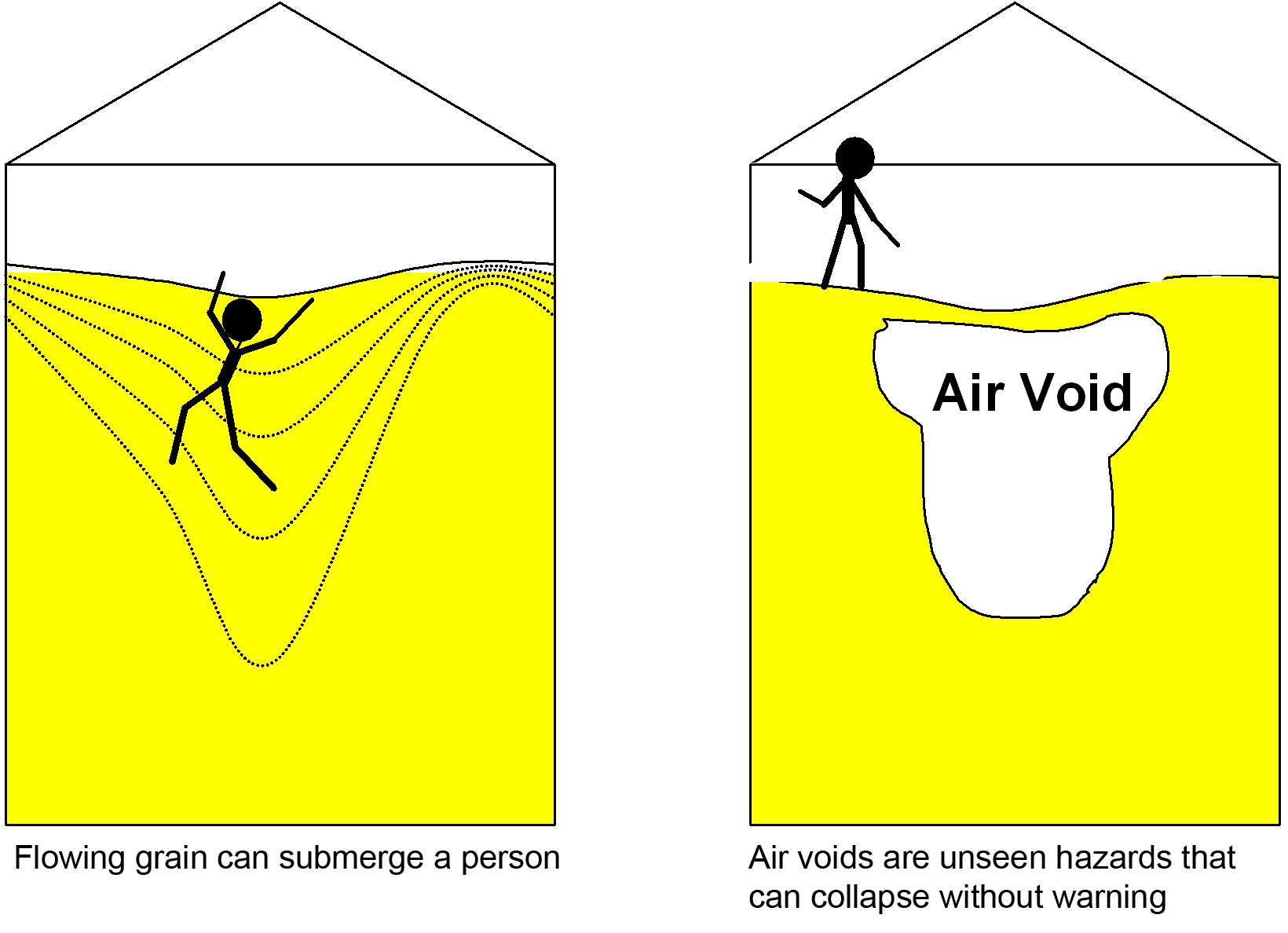
Another factor is lack of a breathable atmosphere in the grain. Typically, you require a specific volume of air. In a grain-handling incident, grain restricts the air flow to the area surrounding you. As you use oxygen and exhale carbon dioxide, the air surrounding you is depleted of its oxygen.
The typical round, flat-bottomed grain bin draws grain from the top center and forms a vertical cone when emptying. Your body volume can be completely submerged in grain in about 8 seconds (picture above). Because of the tremendous force flowing grain exerts on your body, you are totally helpless to escape once you are trapped knee-deep in the grain.
Crusted, spoiled grain can also result in grain bin suffocation. As grain is removed from the bin, a cavity develops under the crusted surface (picture above). You may start walking on the crusted grain, unaware of the cavity and break through, becoming submerged in the grain, and suffocate.
In addition, spoiled grain can also form large vertical masses. If you try to get the caked material loose, large sections of grain can break off and cover you. This risk increases as the capacity of the bin increases.
Lock Out
You should be able to turn-off and lock-out the power switch, so no one can turn on the power when you or others are working in the grain bin.
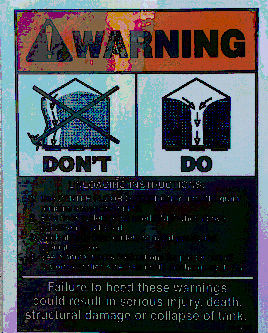 Typical Safety Decal for Grain Bins
Typical Safety Decal for Grain BinsSafety Decals
Place safety decals at strategic locations on the bin to alert workers to the dangers of flowing grain, crusted over grain, and carbon dioxide.
Safe Grain Bin Operation
Suffocation doesn’t have to happen. Follow these safety rules to protect yourself and others:
- Enter bin from the top and use a body harness with a lifeline securely mounted outside the bin. Always have at least two observers outside the bin whenever entry is required.
- Never enter a bin when unloading equipment is running, whether or not grain is flowing.
- Children should NEVER be allowed to play in or around grain bins or hopper wagons.
- Don’t enter a bin with unloading equipment without locking out the control circuit. Be especially careful around automatic unloading equipment.
- Always be cautious when working with crusted, spoiled grain. This grain can result in blockages, cavities, crusting, and grain avalanches. Be prepared for the grain to break free and collapse at any time.
- Never count on a second person outside the bin to hear your shouted instructions. Equipment noise may block out or garble your calls for action or help.
- When you are breaking up large masses or steep piles of caked grain, use a long pole and work from a manhole above the grain. Use a wooden pole because of the danger of overhead power lines.
- If you become trapped in a bin of flowing grain with nothing to hold onto but you are still able to walk, stay near the outside wall. Keep walking until the bin is empty or grain flow stops.
- If you are covered by flowing grain, cup your hands over your mouth, and take short breaths. This may keep you alive until help arrives.
Grain Bin Rescue Procedures
If someone begins sinking into the grain, rescue operations should begin as rapidly as possible. Always assume that the person trapped in the grain, even if completely submerged, is alive. Turn on aeration fans if the air is not automatically heated.
The most successful way to rapidly remove a victim is to cut large holes around the base of the bin, approximately 5 feet up from the base. (Always beware that if you cut too many holes, the bin may collapse on you.) Cutting holes reduces the volume of grain from the bin in the shortest period of time. Gain access into the grain bin side walls by using the front-end loader of a tractor, an abrasive saw, or an air chisel. A cutting torch is a last resort because of the dangers of fire and explosions from dust and fumigant residue.
Using a drum with both ends cut to drop around the victim is another rescue technique. The drum in place around the victim acts as a bridge and reduces the force of the grain on the trapped victim. An old tire can also be used in a similar way to help support a partially-submerged person. When you must enter the grain bin, always have three people involved. It takes two people outside to lift one person from the inside on a rope and body harness, while the third goes for help.
Enter with a rope and safety harness so they can lift you out in case of an incident.
- Rescue Plans - Employees working with grain bins should be aware of the rescue plan. A written emergency plan containing information on the alarm system and evacuation procedures (including a safe meeting place) should be developed.
Grain Dryers
Grain dryers may reach a maximum temperature of 240 degrees F during the drying operation. A fire extinguisher should be available. Also, be aware of the high noise levels created by the high-speed, high-volume fans used with grain dryers. Wearing ear muffs will protect you from permanent hearing damage, which can occur after exposure to high noise levels for long periods.
Grain Auger Safety
Real-World Incident (NIOSH FACE Report 95IA047)
In October 1995, a 65-year-old man was killed while helping a farmer friend harvest corn. The man was unloading corn from a large gravity flow wagon into a floor hopper and a conveying system at the farmer’s private grain facility. He had removed a portion of the steel grating covering the hopper to help unload the corn. While finishing the unloading, he apparently slipped and caught his leg in the partially unguarded moving auger. His right leg was severed in the mid-thigh region. The man was found lying unconscious next to the hopper with significant bleeding. The auger was still running at the time he was found by the farmer’s mother.
Before Operation
Grain augers are used to transport grain from a grain wagon to the grain bin, from the grain bin to a wagon and from the harvester to the grain cart. They are usually exposed to the weather during the off-season and can become rusted and difficult to operate at the beginning of the season. Before the season, inspect the grain auger and perform maintenance as follows:
- Check that all guards are in place, properly secured, and functional. The guard surrounding the auger intake is critically important. Replace all safety decals that are worn, missing, or illegible. These decals can be purchased from the grain auger manufacturer.
- Inspect the condition of the winch and lift cable (or other lifting system). There should be at least three complete wraps of cable around the winch drum in the “full down” position. The cable anchor on the winch drum must be tight. Replace lift cable if frayed or damaged.
- Check fasteners for tightness. Belts and chains should be in good condition and properly adjusted.
- Check oil levels in the gear box and drive box. Lubricate the machine as specified in the owner’s manual.
- Before moving, check around the auger for wasp nests, rodents and snakes that have made nests while the equipment was in storage.
Moving into Working Position
- Never move an auger manually. Augers should always be empty before lifting or moving. When releasing from or attaching to the towing vehicle, test the intake end for downward weight. Lift slowly and keep the intake end no higher than the tractor drawbar. Don’t push the undercarriage.
- Make sure the auger is clear of obstructions and electrical wires in the travel path.
- Move the auger into working position with the towing vehicle.
- Once in place, the auger should be anchored at the intake end and/or supported at the discharge end.
- Never attempt to increase auger height by positioning wheels on lumber or blocks.
Safe Operation
- Keep children and untrained people away from auger work area. The area around the auger is not safe for untrained personnel and especially not safe for children.
- Have another person nearby who can shut down the auger.
- Ensure that the auger is empty before raising or lowering.
- Augers are not insulated. Keep away from all electric lines. Electrocution can occur without direct contact.
- Wear hearing protection when operating the auger.
- Do not operate with any safety shields removed. Exposed auger flighting should be guarded.
- Anchor or support discharge end to further stabilize auger and prevent tipping.
- Keep away from the intake hopper during operation.
- Lower auger at completion of operation, or when not in use. The auger could drop rapidly in case of cable break or hydraulic failure.
- Do not get on or beneath the auger when raising or lowering the intake hitch jack, or when the auger is supported by hitch jack.
- Never attempt to grab the spinning crank if the lift mechanism breaks out of control.
- Block the wheels and support the head of the auger or conveyor when it is in operation.
- Never go under an auger or elevator as it is being raised.
- Operate the auger on level ground.
Hydraulically Driven Auger
- Relieve all pressure before disconnecting fluid lines.
- Before applying pressure, make sure all connections are tight and components are in good condition.
- Never use your hand to check for suspected leaks under pressure. Use a piece of cardboard or wood for this purpose. Repair if damaged.
- If injured by leaking fluid, see your doctor immediately.
- Remember that a hydraulic lift is faster than a conventional hand crank. Extra caution must be taken to clear area of personnel before raising or lowering.
PTO Driven Auger
- Never use a PTO driveline without a rotating shield in good working order. Also ensure shields on auger boot and tractor are in place.
- Be certain the PTO driveline is securely attached to the auger and tractor before operating.
- Before starting the tractor, be certain that power to the PTO and to the hydraulic system is not engaged.
Electric Motor Driven Auger
- Shut off and lock out all power to the auger before servicing, cleaning or adjusting.
- Perform any necessary maintenance on the motor as recommended by the manual.
- Check connectors and fasteners to the motor before operation.
Safe Transport and Storage
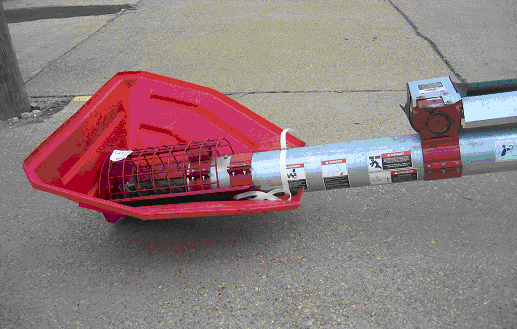 Auger with Proper Shielding and Safety Decals
Auger with Proper Shielding and Safety DecalsThe approach to transport safety is no different from that of operational safety. Remember to:
- Transport the auger empty and in the full down position, securely fastened.
- The hitch pin should be securely attached and a safety chain connected to the auger and the towing vehicle.
- Always attach an SMV (Slow Moving Vehicle) sign before transporting the auger over public roads.
- Equip the auger with the necessary lights for transportation where required by law.
- Before moving the auger, make sure the area around the auger is clear of obstructions and/or unauthorized personnel.
- Never allow anyone to stand underneath or ride on an auger while it is being transported.
- Use extreme caution in turning and cornering.
- Do not raise or lower the auger until area is clear of other workers.
- Watch for overhead obstructions and electrical wires.
- Augers should be stored in the “full down” position with the intake end anchored. This protects the auger against wind and also eliminates the possibility of an inexperienced operator hooking up to a raised auger and driving the unit into an overhead power line.
Auger Shutdown Guidelines
It is important that augers be shut down safely to avoid potential safety hazards both at shutdown and when the auger is re-started for the next loading or unloading task.
Normal shutdown
- Make sure auger is empty before stopping equipment unless stopping the equipment in an emergency.
- The power source should be “locked out” before you leave the work area.
Emergency shutdown
- If an auger has to be immediately shut down under load, disconnect and lock out the power source. Clean as much grain from the hopper and auger as possible.
Summary
Don’t let a grain storage, handling or harvesting incident happen to you or a member of your family. Discuss with each family member and worker the potential dangers of suffocation, entanglement and allergic reactions. Carefully observing prevention procedures and installing safety design features in grain bin storage, handling and harvesting equipment can prevent injuries and fatalities.
References
ANSI/ASAE S351. 1998. Hand Signals for Use in Agriculture. 2003 ASAE Standards, St. Josephs, Mich.
J&M Mfg. Co., 525-14W Operators Manual, Single Auger Grain Cart, Ft. Recovery, Oh.
Johnson, S.B., and D.L. Cyr. 2002. Combines and Corn Picker Safety, Univ. of Maine Extension, Bulletin #2343.
National Safety Council, Agricultural Division, Grain Bin Safety, 1121 Spring Lake Drive, Itasca, Ill 60143. www.nsc.org
NIOSH FACE Investigations and Fatal Agricultural Incidents. Center for Diseas Control and Prevention. www.cdc.gov/niosh/
Ohio State Tailgate Safety Training. 2004. Training Module - Grain Bin Entrapment, The Ohio State University Extension Service.
Westfield Grain Augers, W130 – 51/61/71’ PTO-SD, Assembly and Operations Manual, Rosenort, Manitoba, Canada.
Status and Revision History
Published on Oct 15, 2007
In Review for Minor Revisions on Oct 15, 2010
Published with Full Review on May 25, 2012
Published with Full Review on Apr 11, 2017


























































